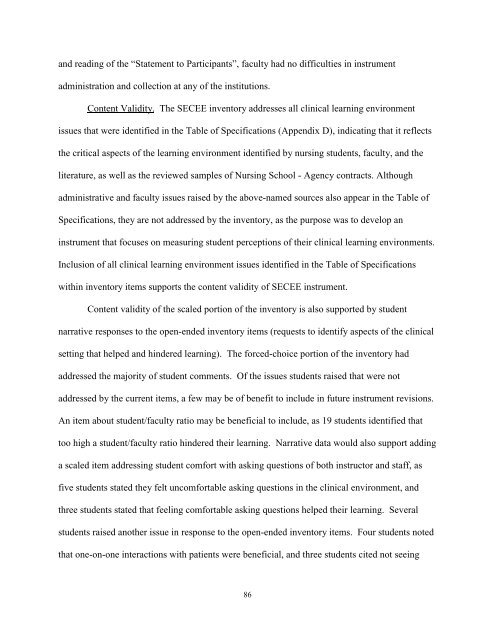STUDENT EVALUATION OF CLINICAL EDUCATION ENVIRONMENT
STUDENT EVALUATION OF CLINICAL EDUCATION ENVIRONMENT
STUDENT EVALUATION OF CLINICAL EDUCATION ENVIRONMENT
Create successful ePaper yourself
Turn your PDF publications into a flip-book with our unique Google optimized e-Paper software.
and reading of the “Statement to Participants”, faculty had no difficulties in instrument<br />
administration and collection at any of the institutions.<br />
Content Validity. The SECEE inventory addresses all clinical learning environment<br />
issues that were identified in the Table of Specifications (Appendix D), indicating that it reflects<br />
the critical aspects of the learning environment identified by nursing students, faculty, and the<br />
literature, as well as the reviewed samples of Nursing School - Agency contracts. Although<br />
administrative and faculty issues raised by the above-named sources also appear in the Table of<br />
Specifications, they are not addressed by the inventory, as the purpose was to develop an<br />
instrument that focuses on measuring student perceptions of their clinical learning environments.<br />
Inclusion of all clinical learning environment issues identified in the Table of Specifications<br />
within inventory items supports the content validity of SECEE instrument.<br />
Content validity of the scaled portion of the inventory is also supported by student<br />
narrative responses to the open-ended inventory items (requests to identify aspects of the clinical<br />
setting that helped and hindered learning). The forced-choice portion of the inventory had<br />
addressed the majority of student comments. Of the issues students raised that were not<br />
addressed by the current items, a few may be of benefit to include in future instrument revisions.<br />
An item about student/faculty ratio may be beneficial to include, as 19 students identified that<br />
too high a student/faculty ratio hindered their learning. Narrative data would also support adding<br />
a scaled item addressing student comfort with asking questions of both instructor and staff, as<br />
five students stated they felt uncomfortable asking questions in the clinical environment, and<br />
three students stated that feeling comfortable asking questions helped their learning. Several<br />
students raised another issue in response to the open-ended inventory items. Four students noted<br />
that one-on-one interactions with patients were beneficial, and three students cited not seeing<br />
86












